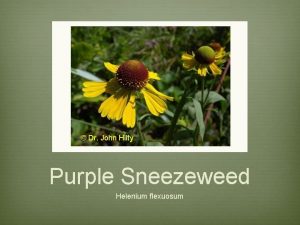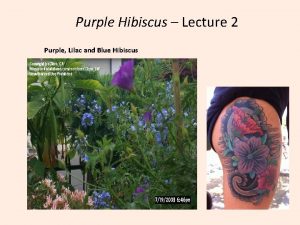Dr John Hilty Purple Sneezeweed Helenium flexuosum Purple









- Slides: 9

© Dr. John Hilty Purple Sneezeweed Helenium flexuosum

Purple Sneezeweed v This time of year one can start to see the rosettes of this year’s perennials. It is a favorite time of year v Rosettes are confusing and sometimes hard to recognize. This is a sneezeweed rosette and grows into one of my favorite plants, I delight in seeing it. v Notice the scalloped © Katy Emde

Plant Details v Bloom Time: June, July, August v 2 -4’ Tall v Flower Color: Yellow, Reddish Brown, Orange. v Grows in a wide variety of soil types. v Stems start to branch in the upper half. © Missouriplants. com

Flowers © Carolyn Fannon © Harry Cliffe v Ray Florets: 8 -13 v Disc Florets: 250 - v Purplish brown ball of disc flowers. v Globoid shape. 500 v Petaloid disc florets are V-shaped and

Leaves v Leaves are alternate. v Leaves up to 5” long and 1” wide. v Sessile, clasping leaves v Winged stem. © Steve Baskauf

Favorite Conditions v Prefers full sun to part shade. v Prefers a moister area, a low area will probably suffice. Tolerates some flooding. v Wet prairies, moist areas in upland prairies, ditches and pastures. v Found in high quality prairies and disturbed areas. © Katy Emde

Wildlife Benefits v Flowerheads offer nectar and pollen. v Visitors include long- tongued bees, shorttongued bees, wasps, flies, butterflies, and skippers. © Don Verser v Insects that eat the plant include butterfly caterpillars, moth caterpillars, and weevils.

Derivation of Genus Name v The genus is thought to have been named by Linnaeus for Helen of Troy. The legend is that the flowers sprung up from the ground where her tears fell. © R. W. Smith

Thanks to v Lady Bird Johnson Wildflower Center v Illinoiswildflowers. com v Discoverlife v All the photographer. s v Missouriplants. com _____ Not currently available for sale _______ © Steve Baskauf

















